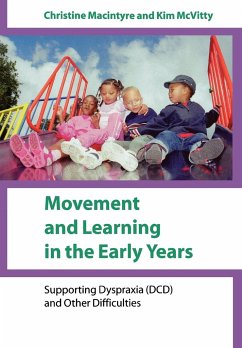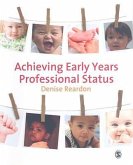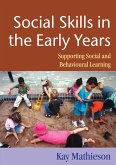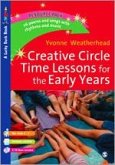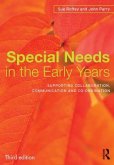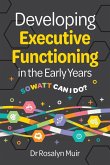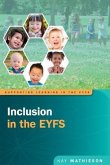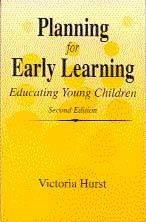Christine Macintyre, Kim Mcvitty
Movement and Learning in the Early Years
Supporting Dyspraxia (DCD) and Other Difficulties
Christine Macintyre, Kim Mcvitty
Movement and Learning in the Early Years
Supporting Dyspraxia (DCD) and Other Difficulties
- Broschiertes Buch
- Merkliste
- Auf die Merkliste
- Bewerten Bewerten
- Teilen
- Produkt teilen
- Produkterinnerung
- Produkterinnerung
This book shows you how to observe a child as they move to allow for early identification of any problems. It then tells you how to help with lots of suggested activities.
Andere Kunden interessierten sich auch für
![Achieving Early Years Professional Status Achieving Early Years Professional Status]() Denise ReardonAchieving Early Years Professional Status49,99 €
Denise ReardonAchieving Early Years Professional Status49,99 €![Social Skills in the Early Years Social Skills in the Early Years]() Kay MathiesonSocial Skills in the Early Years55,99 €
Kay MathiesonSocial Skills in the Early Years55,99 €![Creative Circle Time Lessons for the Early Years Creative Circle Time Lessons for the Early Years]() Yvonne WeatherheadCreative Circle Time Lessons for the Early Years78,99 €
Yvonne WeatherheadCreative Circle Time Lessons for the Early Years78,99 €![Special Needs in the Early Years Special Needs in the Early Years]() Sue RoffeySpecial Needs in the Early Years54,99 €
Sue RoffeySpecial Needs in the Early Years54,99 €![Developing Executive Functioning in the Early Years Developing Executive Functioning in the Early Years]() Rosalyn MuirDeveloping Executive Functioning in the Early Years33,99 €
Rosalyn MuirDeveloping Executive Functioning in the Early Years33,99 €![Inclusion in the Early Years Inclusion in the Early Years]() Kay MathiesonInclusion in the Early Years38,99 €
Kay MathiesonInclusion in the Early Years38,99 €![Planning for Early Learning Planning for Early Learning]() Victoria M HurstPlanning for Early Learning74,99 €
Victoria M HurstPlanning for Early Learning74,99 €-
-
-
This book shows you how to observe a child as they move to allow for early identification of any problems. It then tells you how to help with lots of suggested activities.
Hinweis: Dieser Artikel kann nur an eine deutsche Lieferadresse ausgeliefert werden.
Hinweis: Dieser Artikel kann nur an eine deutsche Lieferadresse ausgeliefert werden.
Produktdetails
- Produktdetails
- Verlag: Sage Publications UK
- Seitenzahl: 162
- Erscheinungstermin: 1. Mai 2004
- Englisch
- Abmessung: 244mm x 170mm x 9mm
- Gewicht: 292g
- ISBN-13: 9781412902373
- ISBN-10: 1412902371
- Artikelnr.: 21463618
- Herstellerkennzeichnung
- Libri GmbH
- Europaallee 1
- 36244 Bad Hersfeld
- gpsr@libri.de
- Verlag: Sage Publications UK
- Seitenzahl: 162
- Erscheinungstermin: 1. Mai 2004
- Englisch
- Abmessung: 244mm x 170mm x 9mm
- Gewicht: 292g
- ISBN-13: 9781412902373
- ISBN-10: 1412902371
- Artikelnr.: 21463618
- Herstellerkennzeichnung
- Libri GmbH
- Europaallee 1
- 36244 Bad Hersfeld
- gpsr@libri.de
Christine Macintyre was formerly Senior Lecturer at Edinburgh University and is now a freelance consultant.
EARLY INTERVENTION IN MOVEMENT AND LEARNING
Part One: Making the Case
Development of the Brain
Self-Esteem
Being Bullied
Part Two: Movement and Learning
The ABC of Learning - Attention. Balance and Control
Differences in Movement Ability
The Importance of Movement Ability
The Size of the Problem
Ways to Help
ANALYSING, OBSERVING AND ASSESSING MOVEMENT
Part One: Analysing Movement
Factors for Analysis
Movement Abilities
Open and Closed Skills
Part Two: Observing and Assessing Movement
Assessment
Observation
Examples of the Process of Assessments
Other Factors in Assessment
LEARNING AND PERCEPTION
Part One: Learning and Movement
Constructivism
The Pace of New Learning
Matching Teaching and Learning Styles
Critical Learning Periods
Part Two: Perception
The Vestibular Sense
The Auditory Sense
The Tactile Sense
The Visual Sense
The Senses of Taste and Smell
The Proprioceptive Sense
The Kinaesthetic Sense
Some Questions for Parents to Consider
HANDWRITING AND MATHEMATICS - A MOVEMENT PERSPECTIVE
Part One: Handwriting
A Sense of Hand Preference/Dominance
Ability to Recognise/Visualise/Remember the Pattern of the Letter or Word
The Strength and Control in Their Shoulder, Arm and Hand
The Necessary Movement Abilities
Enough Spatial/Kinaesthetic Competence
The Correct Resources
Enough Space on the Desktop
Left-Handed Writers
Part Two: Mathematics
Conservation
Visual Perception
Sequencing Difficulties
Counting on the Number Rack
Spatial Understanding in Different Algorithms
Mental Maths
The Confusing Language of Mathematics
PROGRAMMES OF ACTIVITIES FOR PERCEPTUAL-MOVEMENT PROGRAMMES
Introduction
Six Golden Rules
Fun Ways of Teaching
Planning and Organising Movement
The Importance of Practice
APPENDICES
Norms of Development
Competences from the Curriculum Guidance Documents
The Underlying Factors Influencing Movement
A Brief Outline of Specific Learning Difficulties
Part One: Making the Case
Development of the Brain
Self-Esteem
Being Bullied
Part Two: Movement and Learning
The ABC of Learning - Attention. Balance and Control
Differences in Movement Ability
The Importance of Movement Ability
The Size of the Problem
Ways to Help
ANALYSING, OBSERVING AND ASSESSING MOVEMENT
Part One: Analysing Movement
Factors for Analysis
Movement Abilities
Open and Closed Skills
Part Two: Observing and Assessing Movement
Assessment
Observation
Examples of the Process of Assessments
Other Factors in Assessment
LEARNING AND PERCEPTION
Part One: Learning and Movement
Constructivism
The Pace of New Learning
Matching Teaching and Learning Styles
Critical Learning Periods
Part Two: Perception
The Vestibular Sense
The Auditory Sense
The Tactile Sense
The Visual Sense
The Senses of Taste and Smell
The Proprioceptive Sense
The Kinaesthetic Sense
Some Questions for Parents to Consider
HANDWRITING AND MATHEMATICS - A MOVEMENT PERSPECTIVE
Part One: Handwriting
A Sense of Hand Preference/Dominance
Ability to Recognise/Visualise/Remember the Pattern of the Letter or Word
The Strength and Control in Their Shoulder, Arm and Hand
The Necessary Movement Abilities
Enough Spatial/Kinaesthetic Competence
The Correct Resources
Enough Space on the Desktop
Left-Handed Writers
Part Two: Mathematics
Conservation
Visual Perception
Sequencing Difficulties
Counting on the Number Rack
Spatial Understanding in Different Algorithms
Mental Maths
The Confusing Language of Mathematics
PROGRAMMES OF ACTIVITIES FOR PERCEPTUAL-MOVEMENT PROGRAMMES
Introduction
Six Golden Rules
Fun Ways of Teaching
Planning and Organising Movement
The Importance of Practice
APPENDICES
Norms of Development
Competences from the Curriculum Guidance Documents
The Underlying Factors Influencing Movement
A Brief Outline of Specific Learning Difficulties
EARLY INTERVENTION IN MOVEMENT AND LEARNING
Part One: Making the Case
Development of the Brain
Self-Esteem
Being Bullied
Part Two: Movement and Learning
The ABC of Learning - Attention. Balance and Control
Differences in Movement Ability
The Importance of Movement Ability
The Size of the Problem
Ways to Help
ANALYSING, OBSERVING AND ASSESSING MOVEMENT
Part One: Analysing Movement
Factors for Analysis
Movement Abilities
Open and Closed Skills
Part Two: Observing and Assessing Movement
Assessment
Observation
Examples of the Process of Assessments
Other Factors in Assessment
LEARNING AND PERCEPTION
Part One: Learning and Movement
Constructivism
The Pace of New Learning
Matching Teaching and Learning Styles
Critical Learning Periods
Part Two: Perception
The Vestibular Sense
The Auditory Sense
The Tactile Sense
The Visual Sense
The Senses of Taste and Smell
The Proprioceptive Sense
The Kinaesthetic Sense
Some Questions for Parents to Consider
HANDWRITING AND MATHEMATICS - A MOVEMENT PERSPECTIVE
Part One: Handwriting
A Sense of Hand Preference/Dominance
Ability to Recognise/Visualise/Remember the Pattern of the Letter or Word
The Strength and Control in Their Shoulder, Arm and Hand
The Necessary Movement Abilities
Enough Spatial/Kinaesthetic Competence
The Correct Resources
Enough Space on the Desktop
Left-Handed Writers
Part Two: Mathematics
Conservation
Visual Perception
Sequencing Difficulties
Counting on the Number Rack
Spatial Understanding in Different Algorithms
Mental Maths
The Confusing Language of Mathematics
PROGRAMMES OF ACTIVITIES FOR PERCEPTUAL-MOVEMENT PROGRAMMES
Introduction
Six Golden Rules
Fun Ways of Teaching
Planning and Organising Movement
The Importance of Practice
APPENDICES
Norms of Development
Competences from the Curriculum Guidance Documents
The Underlying Factors Influencing Movement
A Brief Outline of Specific Learning Difficulties
Part One: Making the Case
Development of the Brain
Self-Esteem
Being Bullied
Part Two: Movement and Learning
The ABC of Learning - Attention. Balance and Control
Differences in Movement Ability
The Importance of Movement Ability
The Size of the Problem
Ways to Help
ANALYSING, OBSERVING AND ASSESSING MOVEMENT
Part One: Analysing Movement
Factors for Analysis
Movement Abilities
Open and Closed Skills
Part Two: Observing and Assessing Movement
Assessment
Observation
Examples of the Process of Assessments
Other Factors in Assessment
LEARNING AND PERCEPTION
Part One: Learning and Movement
Constructivism
The Pace of New Learning
Matching Teaching and Learning Styles
Critical Learning Periods
Part Two: Perception
The Vestibular Sense
The Auditory Sense
The Tactile Sense
The Visual Sense
The Senses of Taste and Smell
The Proprioceptive Sense
The Kinaesthetic Sense
Some Questions for Parents to Consider
HANDWRITING AND MATHEMATICS - A MOVEMENT PERSPECTIVE
Part One: Handwriting
A Sense of Hand Preference/Dominance
Ability to Recognise/Visualise/Remember the Pattern of the Letter or Word
The Strength and Control in Their Shoulder, Arm and Hand
The Necessary Movement Abilities
Enough Spatial/Kinaesthetic Competence
The Correct Resources
Enough Space on the Desktop
Left-Handed Writers
Part Two: Mathematics
Conservation
Visual Perception
Sequencing Difficulties
Counting on the Number Rack
Spatial Understanding in Different Algorithms
Mental Maths
The Confusing Language of Mathematics
PROGRAMMES OF ACTIVITIES FOR PERCEPTUAL-MOVEMENT PROGRAMMES
Introduction
Six Golden Rules
Fun Ways of Teaching
Planning and Organising Movement
The Importance of Practice
APPENDICES
Norms of Development
Competences from the Curriculum Guidance Documents
The Underlying Factors Influencing Movement
A Brief Outline of Specific Learning Difficulties

